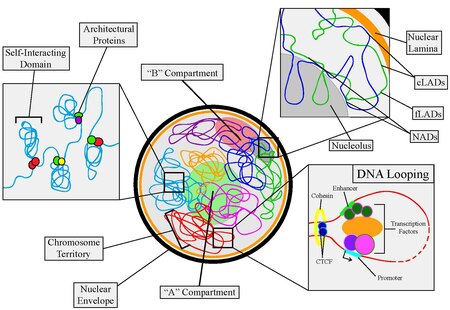This article may be too technical for most readers to understand. (May 2016) |

Nuclear organization refers to the spatial distribution of chromatin within a cell nucleus. There are many different levels and scales of nuclear organisation. Chromatin is a higher order structure of DNA.
At the smallest scale, DNA is packaged into units called nucleosomes. The quantity and organisation of these nucleosomes can affect the accessibility of local chromatin. This has a knock-on effect on the expression of nearby genes, additionally determining whether or not they can be regulated by transcription factors.
At slightly larger scales, DNA looping can physically bring together DNA elements that would otherwise be separated by large distances. These interactions allow regulatory signals to cross over large genomic distances—for example, from enhancers to promoters.
In contrast, on a large scale, the arrangement of chromosomes can determine their properties. Chromosomes are organised into two compartments labelled A ("active") and B ("inactive"), each with distinct properties. Moreover, entire chromosomes segregate into distinct regions called chromosome territories.
© MMXXIII Rich X Search. We shall prevail. All rights reserved. Rich X Search
